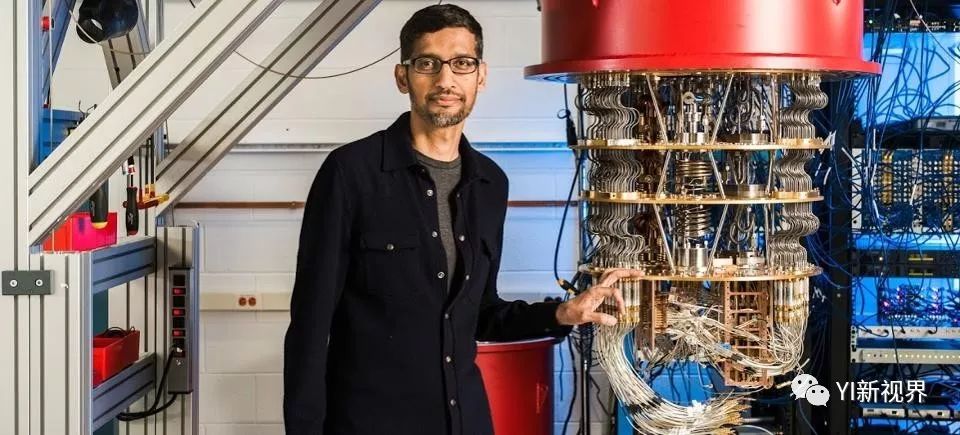
Google CEO Sundar Pichai pictured next to Google's quantum computing setup
This week’s edition of science journal Nature features the modestly titled paper, “Quantum supremacy using a programmable superconducting processor.” But it represents a major milestone in the quantum computing industry and for Google in particular. The paper demonstrates a quantum computer solving a problem, for the first time, significantly faster than a classical computer could.
In a blog post published today, Google CEO Sundar Pichai likened this moment to “the first rocket that successfully left Earth’s gravity to touch the edge of space,” stating “[t]hat’s what this milestone represents for the world of quantum computing: a moment of possibility.”
Google achieved this milestone with its new quantum chip that it’s dubbed “Sycamore.” This is a 54-qubit chip built on a superconducting architecture. The quantum computer takes advantage of a principle of quantum mechanics called “entanglement.” Which means that while a classical computer bit is binary—it exists as “zero” or “one”—a qubit is able to take advantage of a phenomenon known as entanglement to produce a quantum superposition. Put simply, a qubit doesn’t exist as “one” or “zero” but rather a complex linear combination of both, which enables a quantum computer (theoretically) to solve certain classes of problems faster than traditional computers.
The problem is that entanglement is a very delicate process—small environmental changes can impact them, making errors and noise a problem in quantum computing. This is why Google, IBM and others have made quantum chips that operate using superconductors at near absolute zero in an attempt to preserve these fragile entanglements.
In this particular experiment, Google’s researchers were able to connect 53 of Sycamore’s qubits and use them to detect patterns in large, seemingly random numbers. Its computer was able to solve this problem in about 3 minutes and 20 seconds, and the research team calculated it would take 10,000 years for a classical computer to solve the same problem. Though whether this is actually the case is disputed by quantum rival IBM, which wrote in a blog post earlier this week that its team estimates “an ideal simulation of the same task can be performed on a classical system in 2.5 days and with far greater fidelity.”

IonQ's quantum computer operates at room temperature and uses lasers rather than superconductors
A Big Race To Market
Google’s news comes at a time when a lot of energy—and money—is being spent on the development of quantum computers. There are several reasons for this, but one of the biggest is that the biggest driver of computational innovation over the last few decades, Moore’s Law, is slowing down. That reliable increase in computing power over time is fundamentally constrained by physics, and the slowdown in hardware capabilities has the potential to stymie innovation in software as well.
This is where quantum computing steps in. Quantum computers have advantages over classical computing in three areas that are very important to business: logistics optimization (for example, ideal delivery routes), chemical simulation (which can speed up pharmaceutical development) and certain machine learning applications.
While Google’s paper may represent a milestone technologically, it’s facing plenty of competition to bring that technology to customers. Earlier this week, quantum hardware company IonQ announced that it raised $55 million from Samsung and others to accelerate the development of its quantum system, which can run at room temperature. Its trapped ion architecture could potentially be easier to deploy and might produce lower error rates in computation. While it’s still behind on producing chips with as many qubits as Google’s chip, its CEO, Peter Chapman, says the company plans to “double that every year” and will begin offering a quantum cloud service for its hardware in the first quarter of 2020.
Google faces another major rival in IBM, which last month announced the opening of a quantum computation center in Poughkeepsie, New York, to support its Q Network—a quantum cloud service that’s already being used by enterprise customers and software enthusiasts to develop the software for the day when quantum computers reach their potential.
For his part, though, Pichai made little reference to the competition in discussing Google’s achievement, but focused rather on moving the technology forward. “I am excited about what quantum computing means for the future of Google and the world,” he wrote. “Part of that optimism comes from the nature of the technology itself. You can trace the progress from the mega-computers of the 1950s to advances we’re making in artificial intelligence today to help people in their everyday lives.”